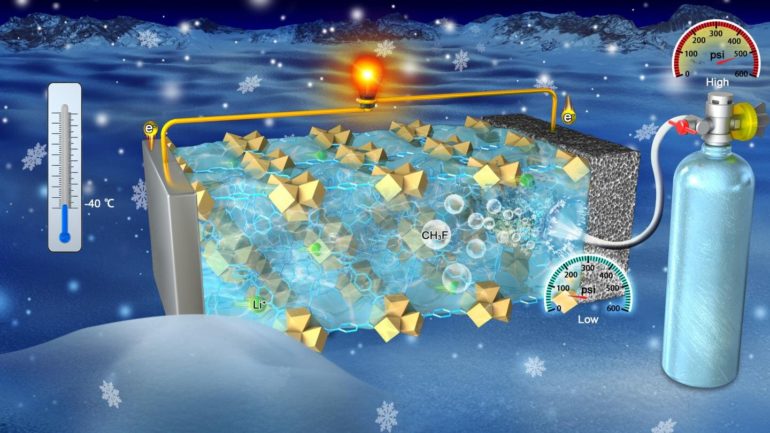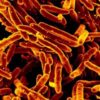A new technology could dramatically improve the safety of lithium-ion batteries that operate with gas electrolytes at ultra-low temperatures. Nanoengineers at the University of California San Diego developed a separator—the part of the battery that serves as a barrier between the anode and cathode—that keeps the gas-based electrolytes in these batteries from vaporizing. This new separator could, in turn, help prevent the buildup of pressure inside the battery that leads to swelling and explosions.
“By trapping gas molecules, this separator can function as a stabilizer for volatile electrolytes,” said Zheng Chen, a professor of nanoengineering at the UC San Diego Jacobs School of Engineering who led the study.
The new separator also boosted battery performance at ultra-low temperatures. Battery cells built with the new separator operated with a high capacity of 500 milliamp-hours per gram at -40 C, whereas those built with a commercial separator exhibited almost no capacity. The battery cells still exhibited high capacity even after sitting unused for two months—a promising sign that the new separator could also prolong shelf life, the researchers said.
The team published their findings June 7 in Nature Communications.
The advance brings researchers a step closer to building lithium-ion batteries that can power vehicles in the extreme cold, such as spacecraft, satellites and deep-sea vessels.
This work builds on a previous study published in Science by the lab of UC San Diego nanoengineering professor Ying Shirley Meng, which was the first to report the development of lithium-ion batteries that perform well at temperatures as low as -60 C. What makes these batteries especially cold hardy is that they use a special type of electrolyte called a liquefied gas electrolyte, which is a gas that is liquefied by applying pressure. It is far more resistant to freezing than a conventional liquid electrolyte.
But there’s a downside. Liquefied gas electrolytes have a high tendency to go from liquid to gas. “This is the biggest safety issue with these electrolytes,” said Chen. In order to use them, a lot of pressure must be applied to condense the gas molecules and keep the electrolyte in liquid form.
To combat this issue, Chen’s lab teamed up with Meng and UC San Diego nanoengineering professor Tod Pascal to develop a way to liquefy these gassy electrolytes easily without having to apply so much pressure. The advance was made possible by combining the expertise of computational experts like Pascal with experimentalists like Chen and Meng, who are all part of the UC San Diego Materials Research Science and Engineering Center (MRSEC).
Their approach makes use of a physical phenomenon in which gas molecules spontaneously condense when trapped inside tiny, nanometer-sized spaces. This phenomenon, known as capillary condensation, enables a gas to become liquid at a much lower pressure.
The team leveraged this phenomenon to build a battery separator that would stabilize the electrolyte in their ultra-low temperature battery—a liquefied gas electrolyte made of fluoromethane gas. The researchers built the separator out of a porous, crystalline material called a metal-organic framework (MOF). What’s special about the MOF is that it is filled with tiny pores that are able to trap fluoromethane gas molecules and condense them at relatively low pressures. For example, fluoromethane typically condenses under a pressure of 118 psi at -30 C; but with the MOF, it condenses at just 11 psi at the same temperature.
“This MOF significantly reduces the pressure needed to make the electrolyte work,” said Chen. “As a result, our battery cells deliver a significant amount of capacity at low temperature and show no degradation.”
The researchers tested the MOF-based separator in lithium-ion battery cells—built with a carbon fluoride cathode and lithium metal anode—filled with fluoromethane gas electrolyte under an internal pressure of 70 psi, which is well below the pressure needed to liquefy fluoromethane. The cells retained 57% of their room temperature capacity at -40 C. By contrast, cells with a commercial separator exhibited almost no capacity with fluoromethane gas electrolyte at the same temperature and pressure.
The tiny pores of the MOF-based separator are key because they keep more electrolyte flowing in the battery, even under reduced pressure. The commercial separator, on the other hand, has large pores and cannot retain the gas electrolyte molecules under reduced pressure.
But tiny pores are not the only reason the separator works so well in these conditions. The researchers engineered the separator so that the pores form continuous paths from one end to the other. This ensures that lithium ions can still flow freely through the separator. In tests, battery cells with the new separator had 10 times higher ionic conductivity at -40 C than cells with the commercial separator.
Chen’s team is now testing the MOF-based separator on other electrolytes. “We are seeing similar effects. We can use this MOF as a stabilizer to adsorb various kinds of electrolyte molecules and improve the safety even in traditional lithium batteries, which also have volatile electrolytes.”
Team develops stable, efficient, anode-free sodium battery
More information:
Guorui Cai et al, Sub-nanometer confinement enables facile condensation of gas electrolyte for low-temperature batteries, Nature Communications (2021). DOI: 10.1038/s41467-021-23603-0
Provided by
University of California – San Diego
Citation:
Stabilizing gassy electrolytes could make ultra-low temperature batteries safer (2021, June 7)
retrieved 7 June 2021
from https://techxplore.com/news/2021-06-stabilizing-gassy-electrolytes-ultra-low-temperature.html
This document is subject to copyright. Apart from any fair dealing for the purpose of private study or research, no
part may be reproduced without the written permission. The content is provided for information purposes only.



